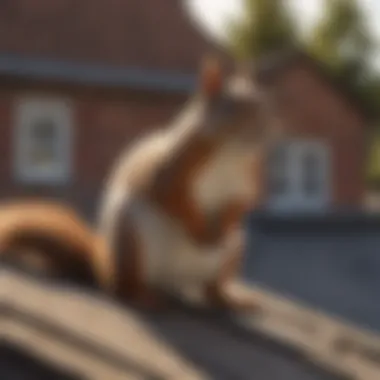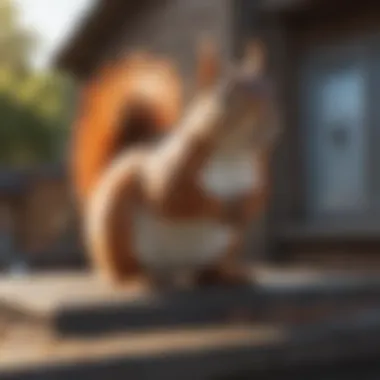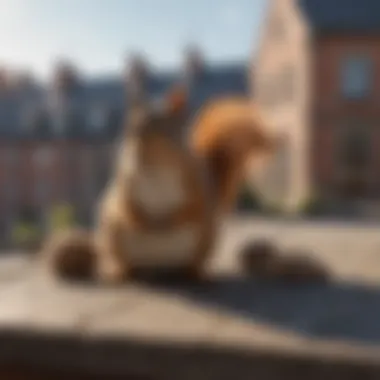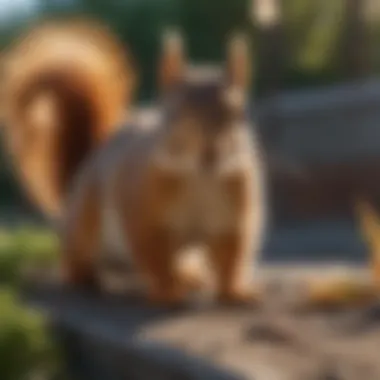Effective Strategies to Remove Squirrels from Your Roof


Intro
Squirrels can create a considerable nuisance for homeowners. Their presence on rooftops is not just a matter of annoyance; it often leads to potential property damage and health risks. Understanding how to identify these pests, taking proactive measures to prevent infestations, and knowing the treatment options available are essential for effective management. This guide aims to provide you with detailed insights and practical advice on how to deal with squirrels infiltrating your roof, ensuring a thorough understanding of the process.
Pest Identification
When addressing a squirrel problem, the first step is accurate identification. The most common type of squirrel that invades roofs is the Eastern Gray Squirrel. These creatures typically have gray fur on their backs and white or pale underparts. Adults usually weigh between 1.5 to 2.5 pounds and are around 16 to 20 inches long, including their bushy tails.
Signs and Symptoms of Infestations
Recognizing the signs of an infestation early can prevent more serious issues down the line. Here are key indicators:
- Noises in the Attic: Scratching or scurrying sounds are often the first indication of squirrels.
- Nesting Materials: Look for shredded insulation or other debris that may serve as nesting material.
- Droppings: Small, dark droppings can be found near entry points or nesting areas.
- Gnaw Marks: Squirrels chew on wood, wires, and insulation, leaving behind noticeable marks.
Identifying these signs promptly allows for swift intervention.
Prevention Strategies
Preventing squirrels from accessing your roof involves regular home maintenance and strategic deterrents. Here are some effective measures:
Home Maintenance Tips for Pest Prevention
- Seal Entry Points: Inspect your roof and home thoroughly. Look for gaps, holes, and any openings where squirrels can enter. Seal these with materials like metal mesh or caulking.
- Trim Overhanging Branches: Cut back tree branches that are close to your roof to deter squirrels from jumping onto your home.
- Maintain Gutters and Roofs: Regular cleaning of gutters can prevent nests from forming. Ensure that your roof is in good condition, with no loose shingles.
Natural Deterrents and Barriers
Some natural methods can also discourage squirrels from approaching:
- Capsicum Peppers: Sprinkling crushed red pepper on areas frequented by squirrels can act as a repellent.
- Essential Oils: Oils such as peppermint or citrus can be effective; placing cotton balls soaked in these oils around entry points may deter them.
- Physical Barriers: Installing squirrel-proof netting around problem areas can physically block them from gaining access.
Treatment Options
When prevention fails, effective treatment options must be considered. Understanding the difference between chemical and natural treatments is crucial.
Overview of Chemical vs. Natural Treatments
- Chemical Treatments: These solutions include pest repellents or traps that may require careful usage due to safety concerns for pets and children.
- Natural Treatments: Options like live traps or humane repellents focus on allowing the squirrels to be relocated safely, minimizing harm.
Step-by-Step Guides for DIY Treatments
If you choose to take a DIY approach, ensure you follow the guidelines carefully:
- Set Up Live Traps: Purchase a humane trap and place it in the squirrel’s active areas with bait such as peanut butter.
- Check Traps Regularly: Inspect traps each morning; squirrels must be released promptly to avoid stress.
- Relocate Far from Home: When capturing squirrels, relocate them at least five miles away from your property.
Important: Always check local regulations regarding the trapping and relocation of animals.
By understanding these components, homeowners can effectively manage squirrel infestations. Future sections will delve deeper into more specific strategies and ethical considerations.
Understanding Squirrel Behavior
Understanding the behavior of squirrels is essential for homeowners facing infestations. Squirrels are clever and resourceful creatures. Recognizing their habits can provide insights into how they invade roofs and what measures can be taken to deter them. By understanding these elements, individuals can make informed decisions that prevent future problems and create a more peaceful living environment.
Common Species That Invade Roofs
Several squirrel species commonly invade homes. The Eastern Gray Squirrel is one of the most prevalent in urban areas. Known for its bushy tail and gray fur, this species is adaptable and learns quickly. Another species, the Fox Squirrel, is larger and often features a reddish coat. Both species are skilled climbers and can easily access rooftops. Their behaviors make them challenging to deter once they have established themselves in an area. Understand the species in your region to tailor removal strategies effectively.
Squirrel Habits and Nesting Behavior


Squirrels are known for their nesting habits. They often build nests in trees, but roofs provide a safe and sheltered environment. Squirrels typically use insulation, leaves, and twigs to create their nests. These nesting habits lead to property damage and potential health risks. It is crucial to recognize signs of nesting, such as gnaw marks and shredded materials, to address the problem early. Being aware of these behaviors helps in taking preventive measures and easing the removal process.
Squirrels will often return to areas where they have nested before, so addressing the problem promptly is vital.
In summary, understanding squirrel behavior provides the foundation for effective removal and prevention strategies. Homeowners will benefit from this knowledge as they navigate the complexities of addressing squirrel invasions.
Signs of Squirrels in Your Roof
Recognizing the signs of squirrels in your roof is crucial for any homeowner. Early detection can prevent significant damage to your property and control the problem before it escalates. Squirrels, while sometimes seen as harmless, can cause severe structural issues, electrical hazards, and even health risks due to their droppings. By identifying the warning signs, you can take prompt action to address the situation.
Listening for Noises
One of the first and most evident signs that squirrels may be taking up residence in your roof is the noise they create. Squirrels are typically active during the early morning and late afternoon, and their sounds can include scratching, scampering, or chattering. These noises may be more pronounced in the attic or cavities within your roof structure. If you notice persistent sounds, it is a strong indicator of their presence. Checking for noises can be a simple, yet effective way to gauge the extent of an infestation. If you hear noises especially in the evening or early morning, it can suggest that squirrels are using your roof as a nesting site.
Observing Physical Damage
Physical damage can also indicate a squirrel problem. Inspect your roof and surroundings for signs that squirrels are gnawing at the materials. Look closely for chew marks on wood, exposed insulation, or even holes in your roof. Squirrels have sharp teeth, which allow them to gnaw through materials quite easily. Damages may not only compromise the integrity of your roof but also create suitable entry points for water and other pests. If you see such signs, they are a clear red flag that squirrels may be living up there.
Evidence of Droppings
Another telling sign of squirrel presence is the discovery of droppings. Squirrel droppings are typically small, about the size of a raisin, and have a dark color. Finding these droppings in your attic, on eaves, or around the entry points can confirm that squirrels have made your roof their home. Besides acknowledging their presence, droppings can also pose health risks. They can carry parasites and diseases, making it essential to act quickly if you observe their waste. Clearing out droppings should be done carefully, preferably with protective gear, to avoid any health issues.
To effectively manage a squirrel situation, vigilance in identifying signs is key. It allows you to take early action and prevents costly repairs in the future.
Identifying Entry Points
Identifying entry points is a critical aspect of managing a squirrel infestation. Understanding how squirrels access rooftops helps homeowners take decisive action against them. Not only does it allow for effective removal, but it also aids in long-term prevention measures. Squirrels can enter through surprisingly small openings, making detection challenging. Therefore, recognizing these vulnerabilities becomes essential to protect your home from these persistent invaders.
Inspection Techniques for Roof Access
To effectively identify entry points, thorough inspection is necessary. Start by examining various areas of your roof and exterior walls. Pay special attention to:
- Roof edges and corners: Look for gaps and openings where shingles may be missing or misaligned.
- Ventilation screens: Check soffit and ridge vents for any damaged areas that could serve as entries.
- Chimney flashing: Inspect around the chimney to find any cracks or voids where squirrels can squeeze through.
- Gutters and downspouts: Look for debris accumulation that might indicate activity or access points.
Use binoculars for a distant view if climbing onto the roof is unsafe. Observing during the early morning or late afternoon, which are peak squirrel activity times, can provide clues about movement patterns. It may help to document findings with photographs for thorough analysis.
Common Entry Areas to Look For
Squirrels are nimble creatures that exploit even the smallest cracks. Here are common entry areas that warrant attention:
- Holes in the siding: Small holes can serve as access points. Inspect all sides of the house for these vulnerabilities.
- Attic vents: Many homes have ventilators in the attic. If these are loose or damaged, squirrels can enter.
- Overhanging tree branches: Trim branches that extend too close to the roof. Squirrels can jump great distances, thus trees provide direct access.
- Fascias and soffits: Look closely at where these materials meet the roofline, as they are frequently overlooked.
By systematically checking these areas, you increase your chances of pinpointing existing entry points. Once identified, you can then strategize on removal and prevention.
Ethical Considerations and Legal Aspects
Understanding the ethical implications and legal regulations surrounding wildlife removal is critical when dealing with squirrel infestations. Homeowners often feel compelled to act swiftly to protect their property, but it is important to navigate these issues responsibly. Failing to consider the laws can lead to unintentional violations, and ignoring ethical standards can result in unnecessary harm to animals.
Understanding Wildlife Protection Laws
Wildlife protection laws in many areas provide guidelines that homeowners must adhere to when removing squirrels. Certain species of squirrels may have special protections, particularly in urban settings where they have adapted to live alongside humans. For instance, in many states, it is illegal to harm or kill native wildlife without proper permits. Finding information about local laws is essential for legally compliant actions.
Typically, homeowners should contact local wildlife agencies or consult official guides to understand these laws. Some jurisdictions may require notification or assistance from licensed wildlife control services before any removal efforts can begin. Ignoring these regulations can result in fines or penalties and potentially cause harm to the local ecosystem.
Ethics of Wildlife Removal
Beyond legal regulations, ethical considerations play a significant role in how homeowners approach squirrel removal. It is paramount to view wildlife not just as pests but as part of a larger ecosystem.


Humane removal methods should be prioritized. This can include using traps that capture rather than kill, allowing for relocation to appropriate habitats away from urban settings. Before taking any actions, homeowners might consider the natural behaviors of squirrels, understanding their need for food and shelter. Actions driven by fear or annoyance can lead to unnecessary harm.
Furthermore, providing education on the sustainable coexistence with wildlife can also be beneficial in preventing future infestations. This proactive approach involves creating environments that discourage squirrels from entering but do not harm them in any way.
By balancing ethical considerations and legal aspects, homeowners not only protect their property but also contribute positively to their local environment.
Effective Removal Strategies
Addressing squirrel infestations requires a strategic approach. Effective removal strategies not only focus on the immediate task of getting rid of squirrels, but also include long-term solutions that help prevent future issues. Homeowners often seek methods that ensure safety for both the residents and the animals involved. Understanding various approaches can aid in making informed decisions and identifying what works best in each unique situation.
Trapping: Techniques and Best Practices
Trapping is one of the most direct methods for removing squirrels from your roof. It is crucial to select the right type of trap, as these need to be humane and effective. Live traps, such as the Havahart traps, allow for capturing squirrels without harming them. Here are some best practices to consider when using traps:
- Location: Place traps near entry points or feeding areas, where squirrels are most likely to encounter them.
- Bait: Use appealing bait like peanut butter, sunflower seeds, or fresh fruits. Ensure the bait is securely attached so squirrels must engage with the trap.
- Timing: Set traps in the early morning or late afternoon when squirrels are most active.
- Check Regularly: Inspect traps frequently to minimize stress to captured squirrels.
After capturing them, it is important to release squirrels far from your home to prevent their return. Some local regulations may specify distances or specific protocols for humane release; be sure to verify these laws.
Deterrents: Chemical and Non-Chemical Options
Deterrents can also play a crucial role in keeping squirrels away. There are both chemical and non-chemical options available.
Chemical Deterrents:
- Commercial Repellents: Products that contain natural ingredients like capsaicin can deter squirrels from certain areas. These require regular reapplication, especially after rain.
- Odor-based Deterrents: Ingredients such as predator urine can discourage squirrels by making the area seem less safe.
Non-Chemical Deterrents:
- Physical Barriers: In some situations, using mesh screens or metal barriers can effectively block entry points.
- Motion-activated Devices: Devices that emit sound or water can scare squirrels away without causing them harm.
- Reflective Objects: Hanging reflective tape or using shiny ornaments can create an unsettling environment for squirrels.
Applying a combination of these deterrent methods increases effectiveness. The goal is to make your roof less appealing to them over time.
Professional Pest Control Services
Sometimes, while DIY methods work wonders, an infestation may require the expertise of professionals. Professional pest control services can assess the situation accurately, providing tailored solutions based on the extent of the issue.
- Assessment: Licensed pest control experts often conduct a thorough inspection, identifying entry points and assessing damage caused by squirrels. This can lead to a more comprehensive strategy.
- Removal Techniques: They may use advanced traps, exclusion techniques, and other methods tailored to the specific needs of the home.
- Ongoing Support: Professionals typically offer follow-up services to monitor the area and ensure that squirrels do not return.
Many homeowners find that the investment in pest control services saves time and prevents further property damage. It's essential to choose a reputable company that prioritizes humane and ethical methods.
"When it comes to managing wildlife, understanding both behavior and effective tactics is vital. By employing these methods, you pave the way for a squirrel-free living environment."
By integrating trapping, deterrents, and options for professional help, homeowners can effectively navigate the challenges of squirrel infestations. This comprehensive approach not only addresses immediate concerns but also fosters long-term peace of mind.
Preventive Measures to Avoid Future Infestations
Preventing squirrel infestations is crucial for maintaining the integrity of your home. While removing these creatures from your roof is important, proactive measures are equally vital to avoid future issues. Implementing effective preventive strategies helps to protect your property from damage and ensures a more peaceful living environment. Let’s explore key tactics to enhance your home’s defenses against squirrel invasions.
Sealing Off Entry Points
The first step in prevention involves sealing off potential entry points. Squirrels are agile creatures. They can squeeze through surprisingly small openings. Common areas to inspect include gaps around vents, gaps under eaves, and cracks in the roofline.
To start, thoroughly inspect your roof and surrounding areas. Use materials like steel mesh or hardware cloth to cover identified gaps. Caulking can also be effective on smaller cracks. Ensure these points are sealed tightly. It is essential that repairs are done quickly, as squirrels tend to return to familiar places.
Remember:
- Pay attention to areas where wires and pipes enter the home.
- Consider using a beacon light or sound deterrents in areas you cannot seal.
- Regularly check these spots to ensure they remain secure.


Landscaping Adjustments to Deter Squirrels
Your yard can play a significant role in either encouraging or deterring squirrels. They are often attracted to food sources and shelter. Landscaping adjustments can make your property less appealing to them.
Here are some practical tips:
- Trim Trees: Keep tree branches trimmed at least six feet away from your roof. This limits access from trees.
- Limit Food Sources: Squirrels are natural foragers. They might be drawn to your garden or bird feeders. Use squirrel-proof feeders and plant less appealing vegetation.
- Mulch: Avoid using mulch with nuts or seeds. Instead, use rocks or pine needles to deter digging and nesting.
Adjustments in your landscaping not only minimize squirrel attractions, but they also beautify your home.
Regular Maintenance Checks
Consistent home maintenance is essential. Regular checks can help you identify potential problems before they grow. Schedule routine inspections of the exterior of your home and roof. Look for signs of wear that could create entry opportunities.
In addition, consider:
- Inspecting Roof Shingles: Look for loose or damaged shingles that squirrels can pry off.
- Evaluating Gutters: Ensure your gutters are clean and free from debris. Clogged gutters may create opportunities for nesting.
- Checking the Attic: A quick attic inspection can reveal signs of entry from squirrels that may have found their way inside.
By maintaining your property and regularly inspecting these areas, you can proactively prevent infestations.
Failure to maintain your home can result in costly repairs and ongoing wildlife issues.
Implementing these preventive measures greatly reduces the chance of squirrels returning to invade your roof. Taking these steps shows a commitment to maintaining your home and safeguarding against unwanted guests.
Monitoring and Follow-Up
After successfully removing squirrels from your roof, the concern should not end there. Monitoring and follow-up are critical components of maintaining a long-term solution to prevent these animals from returning. This section focuses on the importance of ongoing assessment and vigilance in the context of a squirrel-free home.
Successful wildlife removal isn’t just about immediate results but also about ensuring that the issue doesn’t reoccur.
Assessment of Removal Success
The first step in the monitoring process involves evaluating the effectiveness of the removal strategy employed. Homeowners should take time to assess whether the measures taken achieved the intended outcomes. Here are some key considerations to evaluate:
- Listening for Activity: Pay attention to any noises like scratching or chattering emanating from your roof or attic. If sounds persist, it may indicate that squirrels were not removed effectively.
- Physical Inspection: Conduct a visual check to ensure there are no remaining signs of squirrel presence, such as droppings or nesting materials.
- Duration: Monitor your roof for a specified period, ideally a few weeks, to see if squirrels attempt to return. This observation period is essential to confirm removal success.
By being proactive, homeowners can identify lingering issues before they escalate into new infestations.
Continuous Surveillance for New Activity
Even after successful removal, ongoing vigilance is vital. Squirrels may be persistent, and new ones may seek to invade. Continuous surveillance should include:
- Routine Checks: Regularly inspect the roof and surrounding areas for any signs of re-entry. This includes looking for fresh droppings, chewed materials, or other indicators of animal activity.
- Install Cameras: Consider using wildlife cameras to monitor critical areas around your property, especially entry points. These devices can offer peace of mind and quickly alert you to any new invasions.
- Assessment of Surroundings: Sometimes, environmental factors may attract new squirrels. Maintain the landscape around your home by removing potential food sources such as bird feeders or trash bins that may entice them back.
Culmination
The removal of squirrels from residential roofs is not just an issue of aesthetics or annoyance; it represents a critical intersection of human habitation and wildlife behavior. Understanding the needs, behaviors, and potential risks associated with these creatures offers homeowners essential tools for effective management.
The need for strategic interventions arises from the various problems that squirrels can cause, including structural damage and health concerns related to droppings and nesting materials. Fostering awareness about prevention can substantially reduce the likelihood of future infestations.
By employing effective removal strategies, securing entry points, and consistently monitoring for new activity, homeowners can cultivate a proactive approach to wildlife management. Engaging with ethical practices in this context ensures the humane treatment of animals while recognizing their right to coexist within environments that are also used by humans.
"Preventative measures are not merely recommendations; they are critical strategies in maintaining a harmonious living environment."
Finally, the importance of prevention cannot be overstated. Squirrels are resourceful creatures, and without proper precautions, they can quickly return once removed. A comprehensive understanding of the situation coupled with diligence can lead to a squirrel-free home, ensuring peace of mind for homeowners.
Recap of Strategies and Importance of Prevention
In summary, the strategies for addressing squirrel issues can be distilled into several key points:
- Awareness: Recognizing signs of infestation often before they escalate is paramount.
- Identifying Entry Points: A thorough inspection can help pinpoint weaknesses in your roofing structure that need attention.
- Effective Removal: Utilizing traps and deterrents is essential for immediate resolution.
- Preventive Measures: Sealing up entrances and altering landscaping to make areas less appealing to squirrels can significantly cut down future risks.
- Continuous Monitoring: Regular checks can ensure that previous measures remain effective.
Emphasizing these practices not only protects the home but also contributes to responsible wildlife management, ultimately helping homeowners maintain a better quality of life.



